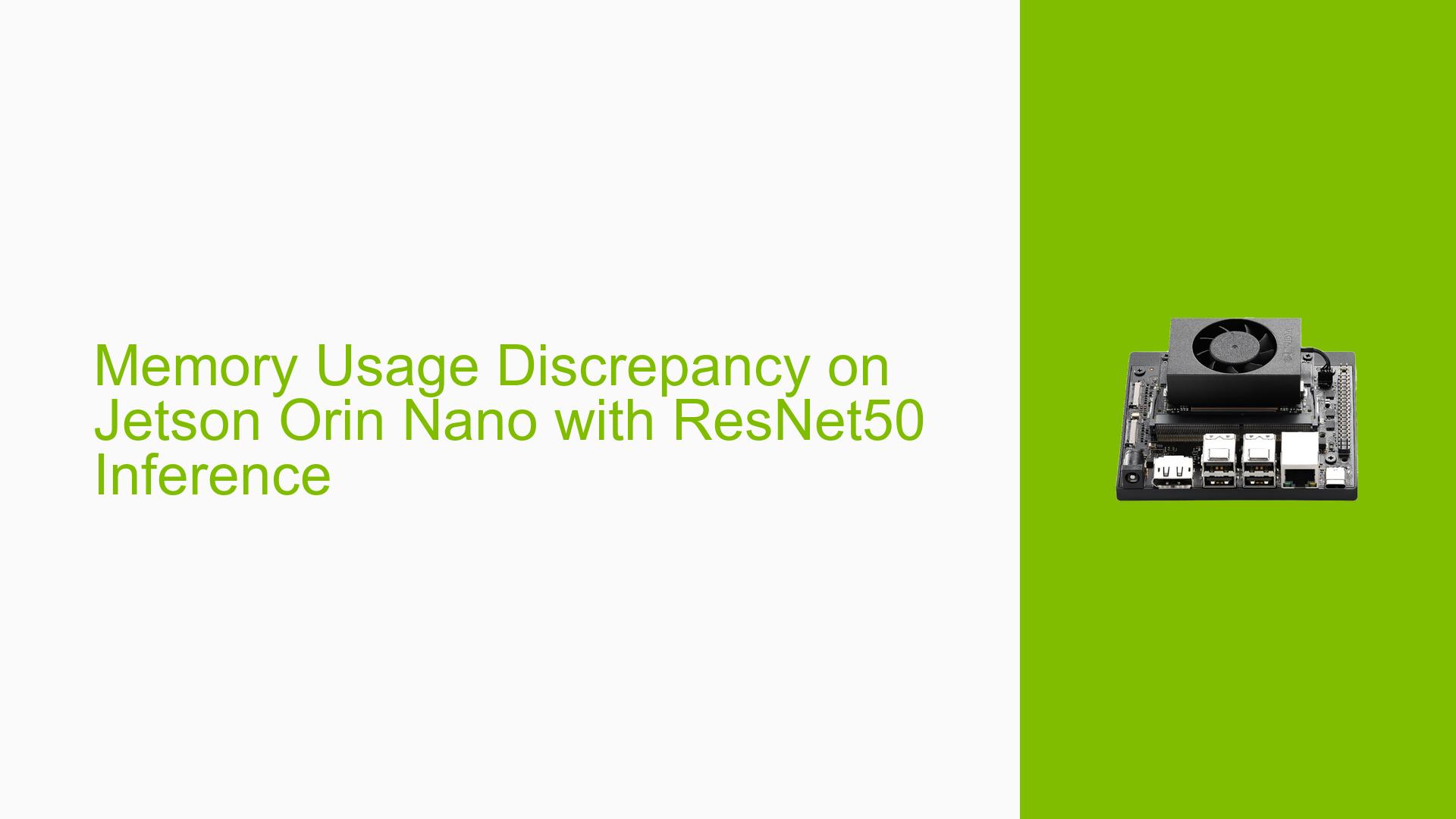Memory Usage Discrepancy on Jetson Orin Nano with ResNet50 Inference
Issue Overview
Users of the Nvidia Jetson Orin Nano (8GB RAM) are experiencing a discrepancy in memory usage when accelerating the inference of ResNet50 using PyTorch. The issue manifests as follows:
- Observed memory usage in Jtop: 2.5GB
- GPU Shared RAM usage: Only about 1.4GB
This significant difference between the total used memory and the GPU Shared RAM is causing confusion among users. Additionally, there are concerns about why ResNet50 is consuming such a large amount of memory during inference.
The issue occurs in the following environment:
- Jetpack: 5.1.3
- CUDA: 11.4
- cuDNN: 8.6
- PyTorch: 1.13
Possible Causes
-
Memory Allocation for CUDA: The discrepancy might be due to additional memory allocated for CUDA operations, which is not reflected in the GPU Shared RAM metric.
-
PyTorch Memory Management: PyTorch’s memory management system may be reserving additional memory for caching or optimization purposes, leading to higher overall memory usage.
-
Model Architecture Complexity: ResNet50 is a deep neural network with many layers, which could require significant memory for storing intermediate activations and gradients during inference.
-
Inefficient Memory Usage: The implementation might not be optimized for memory efficiency, leading to unnecessary memory allocation.
-
System Overhead: Additional memory might be used by the operating system or other background processes running on the Jetson Orin Nano.
-
Memory Fragmentation: Over time, memory fragmentation could lead to higher memory usage than expected.
Troubleshooting Steps, Solutions & Fixes
-
Analyze Memory Usage:
- Use NVIDIA’s
nvidia-smicommand to get detailed GPU memory usage information:nvidia-smi -q -d MEMORY - Monitor memory usage over time using
tegrastats:tegrastats --interval 1000
- Use NVIDIA’s
-
Optimize PyTorch Memory Usage:
- Enable memory-efficient operations in PyTorch:
torch.backends.cudnn.benchmark = True - Use memory-efficient implementations of ResNet50:
model = torchvision.models.resnet50(pretrained=True).to('cuda') model = torch.jit.script(model) # JIT compilation for better memory efficiency
- Enable memory-efficient operations in PyTorch:
-
Implement Model Optimization Techniques:
- Use model quantization to reduce memory footprint:
from torch.quantization import quantize_dynamic quantized_model = quantize_dynamic(model, {torch.nn.Linear}, dtype=torch.qint8) - Employ model pruning to reduce the number of parameters:
import torch.nn.utils.prune as prune prune.l1_unstructured(model.conv1, name='weight', amount=0.2)
- Use model quantization to reduce memory footprint:
-
Manage CUDA Memory:
- Clear CUDA cache periodically:
torch.cuda.empty_cache() - Set a maximum memory usage limit:
torch.cuda.set_per_process_memory_fraction(0.8) # Limit to 80% of available memory
- Clear CUDA cache periodically:
-
Profile the Application:
- Use NVIDIA’s Nsight Systems to profile the application and identify memory bottlenecks:
nsys profile python your_script.py - Analyze the profile to identify areas of high memory usage and optimize accordingly.
- Use NVIDIA’s Nsight Systems to profile the application and identify memory bottlenecks:
-
Update Software Stack:
- Ensure you’re using the latest compatible versions of JetPack, CUDA, cuDNN, and PyTorch for potential memory-related bug fixes and optimizations.
-
Reduce Batch Size:
- If applicable, try reducing the batch size during inference to lower memory requirements:
model.eval() with torch.no_grad(): output = model(input_tensor.unsqueeze(0)) # Process one sample at a time
- If applicable, try reducing the batch size during inference to lower memory requirements:
-
Investigate System-Level Memory Usage:
- Use
toporhtopcommands to monitor overall system memory usage and identify any unexpected processes consuming memory.
- Use
-
Consider Hardware Upgrade:
- If the memory usage is consistently high and impacting performance, consider upgrading to a Jetson model with more RAM, such as the Jetson AGX Orin.
By following these steps and implementing the suggested optimizations, users should be able to better understand and potentially reduce the memory usage discrepancy on their Jetson Orin Nano when running ResNet50 inference. If the issue persists, it may be necessary to consult NVIDIA’s official documentation or seek support from the Jetson community forums for more specific guidance.
